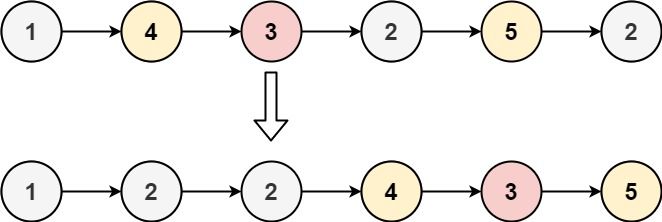Welcome to Subscribe On Youtube
86. Partition List
Description
Given the head of a linked list and a value x, partition it such that all nodes less than x come before nodes greater than or equal to x.
You should preserve the original relative order of the nodes in each of the two partitions.
Example 1:

Input: head = [1,4,3,2,5,2], x = 3 Output: [1,2,2,4,3,5]
Example 2:
Input: head = [2,1], x = 2 Output: [1,2]
Constraints:
- The number of nodes in the list is in the range
[0, 200]. -100 <= Node.val <= 100-200 <= x <= 200
Solutions
Solution 1: Simulation
We create two linked lists, one to store nodes less than $x$, and the other to store nodes greater than or equal to $x$. Then we concatenate them.
The time complexity is $O(n)$, where $n$ is the length of the original linked list. The space complexity is $O(1)$.
-
/** * Definition for singly-linked list. * public class ListNode { * int val; * ListNode next; * ListNode() {} * ListNode(int val) { this.val = val; } * ListNode(int val, ListNode next) { this.val = val; this.next = next; } * } */ class Solution { public ListNode partition(ListNode head, int x) { ListNode d1 = new ListNode(); ListNode d2 = new ListNode(); ListNode t1 = d1, t2 = d2; while (head != null) { if (head.val < x) { t1.next = head; t1 = t1.next; } else { t2.next = head; t2 = t2.next; } head = head.next; } t1.next = d2.next; t2.next = null; return d1.next; } } -
/** * Definition for singly-linked list. * struct ListNode { * int val; * ListNode *next; * ListNode() : val(0), next(nullptr) {} * ListNode(int x) : val(x), next(nullptr) {} * ListNode(int x, ListNode *next) : val(x), next(next) {} * }; */ class Solution { public: ListNode* partition(ListNode* head, int x) { ListNode* d1 = new ListNode(); ListNode* d2 = new ListNode(); ListNode* t1 = d1; ListNode* t2 = d2; while (head) { if (head->val < x) { t1->next = head; t1 = t1->next; } else { t2->next = head; t2 = t2->next; } head = head->next; } t1->next = d2->next; t2->next = nullptr; return d1->next; } }; -
# Definition for singly-linked list. # class ListNode: # def __init__(self, val=0, next=None): # self.val = val # self.next = next class Solution: def partition(self, head: Optional[ListNode], x: int) -> Optional[ListNode]: d1, d2 = ListNode(), ListNode() t1, t2 = d1, d2 while head: if head.val < x: t1.next = head t1 = t1.next else: t2.next = head t2 = t2.next head = head.next t1.next = d2.next t2.next = None return d1.next -
/** * Definition for singly-linked list. * type ListNode struct { * Val int * Next *ListNode * } */ func partition(head *ListNode, x int) *ListNode { d1, d2 := &ListNode{}, &ListNode{} t1, t2 := d1, d2 for head != nil { if head.Val < x { t1.Next = head t1 = t1.Next } else { t2.Next = head t2 = t2.Next } head = head.Next } t1.Next = d2.Next t2.Next = nil return d1.Next } -
/** * Definition for singly-linked list. * function ListNode(val, next) { * this.val = (val===undefined ? 0 : val) * this.next = (next===undefined ? null : next) * } */ /** * @param {ListNode} head * @param {number} x * @return {ListNode} */ var partition = function (head, x) { const d1 = new ListNode(); const d2 = new ListNode(); let t1 = d1, t2 = d2; while (head) { if (head.val < x) { t1.next = head; t1 = t1.next; } else { t2.next = head; t2 = t2.next; } head = head.next; } t1.next = d2.next; t2.next = null; return d1.next; }; -
// Definition for singly-linked list. // #[derive(PartialEq, Eq, Clone, Debug)] // pub struct ListNode { // pub val: i32, // pub next: Option<Box<ListNode>> // } // // impl ListNode { // #[inline] // fn new(val: i32) -> Self { // ListNode { // next: None, // val // } // } // } impl Solution { pub fn partition(head: Option<Box<ListNode>>, x: i32) -> Option<Box<ListNode>> { let mut head = head; let mut d1 = Some(Box::new(ListNode::new(0))); let mut d2 = Some(Box::new(ListNode::new(0))); let (mut t1, mut t2) = (&mut d1, &mut d2); while let Some(mut node) = head { head = node.next.take(); if node.val < x { t1.as_mut().unwrap().next = Some(node); t1 = &mut t1.as_mut().unwrap().next; } else { t2.as_mut().unwrap().next = Some(node); t2 = &mut t2.as_mut().unwrap().next; } } t1.as_mut().unwrap().next = d2.unwrap().next; d1.unwrap().next } }